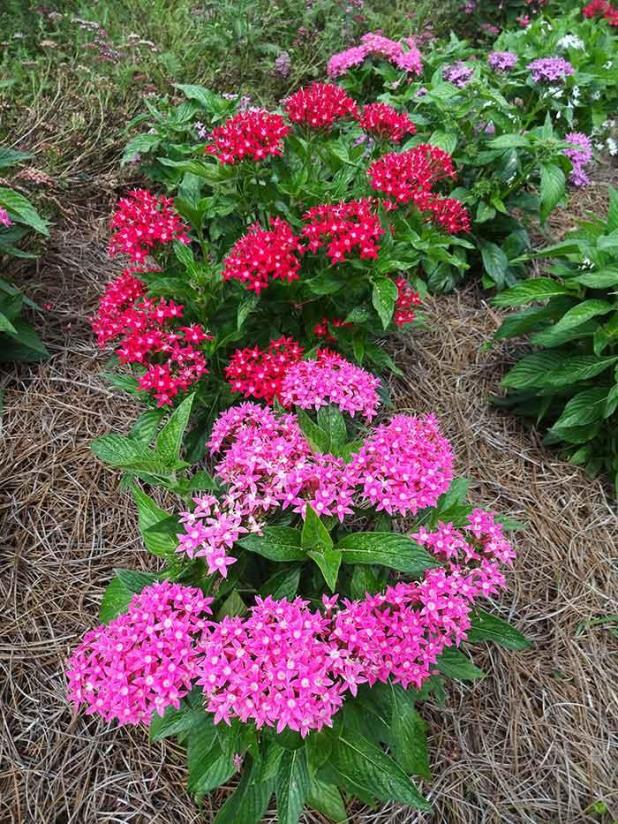
Butterfly pentas is a low-maintenance flower with great blooms through late fall.
—AgCenter/Allen Owings
Colorful summer bedding plants take the heat
Whether in flower beds, containers, hanging baskets or window boxes, summer bedding plants can quickly and economically help create the colorful landscape that so many gardeners crave. Through careful selection, a gardener can grow bedding plants that will thrive despite the sweltering heat of summer.
Bedding plants are classified into two groups based on the temperatures they prefer.
Cool-season bedding plants (such as pansies, dianthus, snapdragons, stock and calendulas) do best in the cold to mild temperatures of October through early May.
Warm-season bedding plants (such as torenia, begonia, marigolds and zinnias) grow and flower best in the warm to hot months of April to October. Because they are sensitive to freeze damage, warm-season plants are planted after the danger of frost is over. Now is the time to plant warm-season bedding plants into new beds in your landscape or as you remove cool-season annuals from existing beds.
True annuals are an important group of bedding plants we use to add color to the landscape. These short-lived plants grow from seed, bloom and die within one growing season. Few true annuals have the stamina to last all the way through our exceptionally long summer growing season of seven months.
Tender perennials, such as impatiens, periwinkles, blue daze, pentas, SunPatiens and begonias, are often grouped with the true annuals. This is because in most parts of the U.S. they only last one season before dying in winter’s freezes. But these plants do not die after a period of blooming as do the true annuals. If not for winter freezes, these plants would live and bloom for several years – and often do here when mild winters occur.
Tender perennials grown as annuals have more stamina than true annuals in the garden. While true annuals may play out before summer’s end, tender perennials bloom from late spring until cold weather arrives in November. They are an excellent choice for Louisiana flower beds.
Choose bedding plants well-suited to the growing conditions in the location where they will be planted. Sunlight is especially important. For beds that receive at least six to eight hours of sunlight each day, choose sun-loving bedding plants. In beds that receive about two to four hours of morning sun, choose bedding plants that prefer shady conditions.
Even bedding plants that like part shade to shady locations, however, will generally not perform as well in full shade where they receive no direct sun during the day. Caladiums, planted from tubers or growing plants, are one of the best choices for color in full shade.
Before you go to the nursery, look at the size of the area to be planted and try to estimate how many plants you will need. On average, bedding plants are spaced about 8 inches apart, but check the tag of the plants you’re considering. Beds will look skimpy when first planted, but the plants should grow to fill the bed when spaced properly. Keep a record of how many plants are used in a bed from one season to the next to make this process simpler.
Prepare beds carefully before putting in the summer bedding plants. A common mistake is to remove the faded plants, half-heartedly turn the soil and then plant the new plants. It takes a lot out of the soil to produce vigorous plants and abundant flowers, so we must give back to the soil if we expect each new planting to do its best.
First, remove any weeds or other unwanted plants from the bed. Next, turn the soil to a depth of about 8 inches. Spread a 2- to 4-inch layer of compost, rotted leaves, aged manure, composted finely ground pine bark or peat moss over the bed. Then evenly sprinkle a light application of an all-purpose fertilizer. Thoroughly blend the organic matter and fertilizer into the bed, rake it smooth, and you’re ready to plant.
Make sure you plant the transplants into the bed no deeper than they were growing in their original container and space them properly.
Once the bed is planted, mulch and thoroughly water-in the plants. I like to use a hose-end fertilizer applicator and water them in with a fertilizer solution to get them off to a good start. Newly planted bedding plants do not have well-established root systems and should be watered thoroughly every few days, or as needed if the weather is dry the first few weeks after planting.
Beds of beautiful flowers are not low maintenance. When deciding where, how large and how many beds you will plant, keep in mind that they will need regular care through the summer.
Warm-season bedding plants for sun to part sun: ageratum, amaranthus, angelonia*, balsam, blue daze*, celosia, cleome (particularly Senorita Rosalita) , coleus* (sun-tolerant types), coreopsis, cosmos (yellow gold and orange flowered types), dusty miller*, gaillardia (short-lived perennial), gomphrena, lantana*, marigold, melampodium, narrow-leaf zinnia, ornamental pepper*, periwinkle*, pentas*, portulaca, purslane*, rudbeckia (Goldsturm is a long-lived perennial), salvia*, scaevola*, sunflower, SunPatiens*, tithonia, perennial verbena and zinnia (Profusion and Zahara perform best).
Warm-season bedding plants for part-shade to shade: balsam, begonia*, browallia*, caladium* (perennial tuber), coleus*, impatiens*, New Guinea impatiens* (Divine and Bounce are recommended), pentas*, salvia* and torenia (Kauai is recommended).
*Tender perennials
